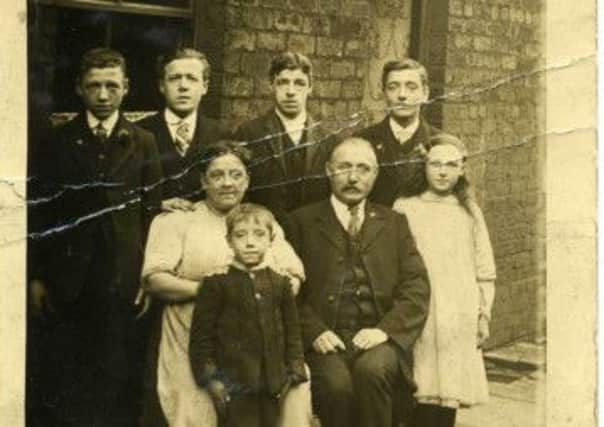Nostalgia with Margaret Watson: Edgar was the first casualty in the war


The first man from Dewsbury to lose his life in the Great War was Edgar Armitage, of Leeds Road, a serving soldier, married with children.
He died eight days after war was declared, but unlike many of his comrades, Edgar didn’t die in battle.
Advertisement
Hide AdAdvertisement
Hide AdHe collapsed and died while at camp preparing to go to France with the rest of his regiment.
Sadly, following a route march, he suffered an embolism and died. His death certificate states he was suffering from tuberculosis, a condition caused or exacerbated by his military service.
Edgar, Dewsbury’s first reported war casualty, died on August 12th 1914, but his name is not listed on the war memorial at Crow Nest Park.
In civilian life he had been a tram driver and before that a coal miner,
Advertisement
Hide AdAdvertisement
Hide AdHe married Frances Emily Buckley at St Paul’s Church, Hanging Heaton, and they had two children, Eleanor and Nellie.
His name is on the war memorial at Hanging Heaton and also on the war memorial at Earlsheaton.
Edgar joined the army in 1893 and was appointed bugler in 1895, serving in South Africa and the East Indies. He served a total of 16 years.
Returning to civilian life he became a motor tram driver, but on the outbreak of war he volunteered to return as a private soldier and was billeted in Doncaster.
Advertisement
Hide AdAdvertisement
Hide AdLocal military historians, Peter Bennett and Alan Kaye, are campaigning to get Edgar’s name placed on the Crow Nest memorial, along with a number of others who they believe should be there.
Alan said Edgar deserved to be recognised because his death was a tragedy of war.
“He deserves a place of honour because he was trying to return to his regiment when his health let him down,” he said.
Edgar was awarded the South African Medal and also the Transvaal King’s Medal.
Advertisement
Hide AdAdvertisement
Hide AdFOUR other men from Dewsbury, all serving soldiers, were also to lose their lives during the first month of the war, all on the same day - August 26 - all killed in action in France..
They were: Alfred Dyer, Oscar Ivinson, George William Taylor, all serving with the KOYLI regiment, and James Phillips, serving with the Lancashire Fusiliers Second Battalion.
James Phillips, from Westtown, was the first parishioner from St Paulinus Church to be killed. His brother, Patrick Edward, a regular soldier, died two months later from sickness in the Middle East, and was buried in Egypt.
Oscar Ivinson, Wakefield Road, Chickenley Heath, was married to Maria Walker and had three children, Charles, George, William and Emma.
Advertisement
Hide AdAdvertisement
Hide AdAlfred Dyer, who was married with a 3 year old son, lived at Armitage Buildings, Batley Carr. He went missing at Mons on the 26th August, and his body was also never found. His name is on the Dewsbury War Memorial, but on the Commonwealth War Graves Commission, he is listed as Joe Winrow, the surname of his stepfather, whose name he served under.
George Taylor lived in Albion Street, Springfield, and was also listed as missing at Mons,
His parents were George and Elizabeth Taylor, and in 1909 he married Sarah Ann Day at St Mark’s Church, Dewsbury.
Many of those killed in the Great War have no known grave and no resting place. Sadly, James Phillips was one of these.
Advertisement
Hide AdAdvertisement
Hide AdHe was originally buried in a grave with 11 others but the grave was disturbed by heavy shelling and lost.
Alan Kaye and Peter Bennett, along with other local historians, Betty Goodwin and Christine Leveridge, are working on a World War One Commemorative project which will be a great help to the families of those killed from Dewsbury.
The project involves checking and confirming all 1,070 names of those listed on the memorial in Crow Nest Park, and also to ensure that any which are missing will be put there as soon as possible. .
All these details will eventually be put on a website to enable local people to gain quick and easy access to information about those who died.
Advertisement
Hide AdAdvertisement
Hide AdTheir first objective is to identify the men whose names are on a special Book of Remembrance which is kept in Dewsbury Library
Unfortunately, upon examining this document, which is hand-written, they found gaps where vital information was missing.
“Part of our project is to fill in these gaps and publish our findings on a website for the benefit of researchers and families,” said Alan.
“We are hoping that local people who have information about relatives whose names should be on the memorial but are missing, will get in touch with us.”
Please e-mail Alan - [email protected]
Advertisement
Hide AdAdvertisement
Hide AdTHERE will be photographs somewhere of the men mentioned above, but I do not have them in my collection.
Therefore I am using a photograph which I used some years ago, but which I believe is appropriate, because it shows the kind of families who lost sons in the war.
This picture of the Chatwood family was taken outside their home in Kilburn’s yard, The Flatts,
Two of the boys pictured, William, far left and Tom, far right, were both killed in 1917 within months of each other.
Advertisement
Hide AdAdvertisement
Hide AdWilliam was killed during the Battle of Passchendaele, and Tom was killed in the Battle of Arras. He has no known grave, but his name is commemorated on the Arras Memorial in France.
Perhaps this family picture was taken shortly before they left to fight., Many families did this because they realised they may never see their boys again.